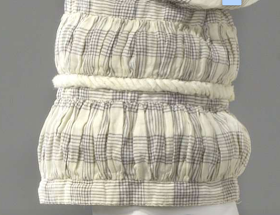Rijksmuseum in Amsterdam
I've been waiting a while to make a copy of this 1811-1815 dress and yesterday my custom printed fabric arrived I bought the barest minimum so have to be careful I don't waste any.
I'm still working out the hem. Have sent an email to the museum, but not sure if they will answer. In the meantime I've started playing around with the possibility the piping is made from the dress fabric as tucks, and not as applied roleaux. Anyway, the experiments will continue until I'm sure.
 |
| Testing out the thin piping at the bottom |
Another thought through my head is that the grid section is sewn together, with an inserted piped cord made from plain ivory cotton, sticking out the front. But surely that would waste fabric? The piping is so pale compared to the rest of the fabric - is it just time and age that has done this? My brand new fabric is quite dark.
When I look up really close I can see vertical stripes in the piping - that is what is confusing me - its like they are still there but almost invisible. Also the fabric is still there behind them with the vertical stripes but the horizontals have gone - would they just cut them away or are they concealed in the piping like my rough pin up shows? Arghh! brain drain......





No comments:
Post a Comment